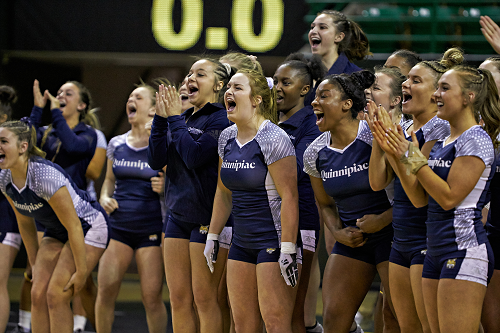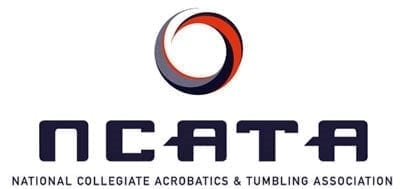
The National Collegiate Acrobatics & Tumbling Association (NCATA) is the organizational body for collegiate acrobatics and tumbling. The sport combines skillsets currently practiced in artistic, acrobatic, trampoline and power tumbling, all internationally recognized and competed disciplines of gymnastics. Acrobatics and tumbling also takes in the athletic aspects of cheerleading.
Acrobatics & Tumbling meets are exciting, fast paced and fan friendly, and incorporate a competition between either two or three teams, each of which can have up to 28 competitors on their game-day roster. Athletes compete in six events throughout the meet, including: Compulsory, Acro, Pyramid, Toss, Tumbling and Team.
In total, teams compete head-to-head in 20 heats during a competition. (A detailed description is here). Teams are evaluated in each heat by a panel of officials, receiving a score based on starting difficulty values and execution of declared skills. In a meet, a team can score up to 300 points. The team with the highest overall score is declared the winner. A breakdown of the event is as follows:
Event 1 – Compulsory - Each team competes identical pre-determined set of skills. There are four heats that include acro, pyramid, toss and tumbling.
Event 2 – Acro – In the Acro Event, teams compete in three different heats of five, six and seven elements. Groups of two to four athletes will compete acrobatic lifts and tosses demonstrating strength, balance and technique from both the bases and tops.
Event 3 – Pyramid – In the Pyramid Event, teams compete in three individual heats building pyramids of three layers. Teams combine an entry, structure and dismount to create a pyramid. Each heat has a different requirement: inverted body position for the top, synchronized and open.

Event 5 – Tumbling – The Tumbling Event features powerful synchronized and individual tumbling passes.
Event 6 – Team – In Team Event, teams perform synchronized choreographed skills in a routine set to music.
With so much going on, it’s no surprise that SDM needed to catch up with the NCATA’s Janell Cook to find out about the sport.
Sports Destination Management: Do you think of acrobatics and tumbling as more of a cheer discipline, or more of a gymnastics discipline?
Janell Cook: It is a blend of both. It’s an evolution of gymnastics and and cheer. It has roots in both sports, but it is competed in a new format.
SDM: How long has it been around?
Cook: The idea of acrobatics and tumbling, as well as the first competitions, began in 2009. NCATA was formed in 2010. At that time, at the college level, there were a lot of cheer athletes who had gymnastics background and a lot of gymnasts who were not being served by existing opportunities. The creators of the sport we now call acrobatics and tumbling got together with college coaches to develop a new opportunity for a wide range of athletes to compete and showcase what they do best.
SDM: You’re an NCAA Emerging Sport for Women. Are there men who are interested in acrobatics and tumbling?
Cook: We would love to see it grow to men but that’s not our focus right now at the collegiate level. In acrobatic gymnastics, you’ll see mixed pairs of athletes competing, though.
SDM: Are you involved with USA Gymnastics?
Cook: Yes – we partner with them to support the growth of both collegiate and youth acrobatics & tumbling. We work to keep pace with them, and to keep growing and developing. USA Gymnastics has stepped up their support of collegiate programs and it’s going to play a big role as we continue our growth.
SDM: Right now, NCATA is involved with collegiate programs, but have you seen any youth acrobatics and tumbling?
Cook: We are starting to see a lot more youth-based programs through USA Gymnastics and some new associations that have been created specifically to help athletes train and compete in the sport.
SDM: Do most of your athletes come from cheer or gymnastics?
Cook: The majority of them come from cheer and gymnastics but we also recruit from many other sports: diving, dance and weightlifting are a few.
SDM: The uniform is completely different from cheer, though.
Cook: Yes, it’s more like a volleyball uniform – shorts and a simple short-sleeved or long-sleeved top.
SDM: Is this a sport that is contested all year long?
Cook: Athletes compete in a regular season on their campuses during the spring season. Training is year round with hours depending on rules within their division.
SDM: Is the sport growing across the U.S. or is it more popular in certain regions?
Cook: If you look at the map of where the schools are that have programs, you’ll see that there is more significant program growth in the Mideast, the Northeast and the Southeast. However, the sport is popular across the country - approximately 60% of NCATA rosters are from out of state. So young women are traveling near and far to take advantage of these competitive opportunities.
SDM: Do you host a national championship?
Cook: Yes, that is held at the end of April.
SDM: Where is it hosted?
Cook: It has been all over since we host each year on a NCATA member campus: Fairmont State University in West Virginia, Azusa Pacific University in Southern California, Gannon University in Erie, Pennsylvania, Baylor University in Texas – this spring we’ll be at the University of Oregon.
SDM: What is your process for selecting a location?
Cook: It’s not too high-tech! We rotate around the country since teams are currently paying their own travel costs. We ask our members to indicate their interest and we have discussions with them. It’s an easy sport to host; you need a gym and thirteen two-inch thick competition mats which fit within the lines of a standard basketball court. Teams have their own bench areas.
SDM: That doesn’t sound too complicated.
Cook: We wanted to make it as simple as possible to host, but even more, we wanted to make it easy to implement a new program on any campus.
SDM: How close are you to hitting NCAA championship status?
Cook: We need 40 NCAA programs to be eligible for consideration; we have 38 right now. We’re very excited; there’s lots of interest so we’re looking forward to the coming year.


